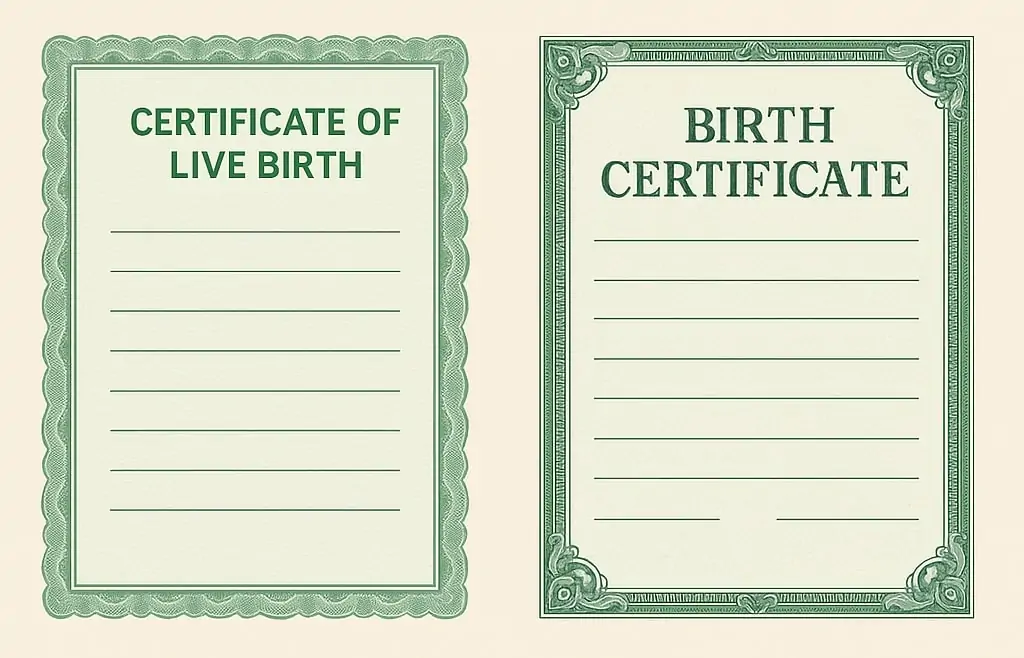Each year, over 3.6 million babies are born in the United States, according to the CDC. Every one of those births generates two documents: a Certificate of Live Birth and a Birth Certificate. While these terms are often confused, they are not the same.
The key legal difference is this:
A Certificate of Live Birth is a hospital-generated form used to record birth details for data entry. It is not a legal document.
A Birth Certificate is the official legal record issued by a state’s vital records office. It is the document used for passports, social security cards, and legal identification.
Global State of Birth Registration

Despite progress, millions of children worldwide still lack legal identity due to unregistered births or the absence of a birth certificate.
| Statistic | Value |
| Children under 5 registered globally | 77% |
| Children under 5 with no registration | 150 million (2 in 10) |
| Children with registered birth but no certificate | 50+ million |
| Sub-Saharan Africa registration rate | 51% |
| Highest regional registration rate | Latin America & Caribbean (95%) |
| Annual births in countries without system-wide registration | 74 million (53.1%) |
Despite global progress in birth registration, large gaps persist in legal identity coverage for young children. Millions remain undocumented, especially in low-income and conflict-affected regions. Sub-Saharan Africa continues to face the largest disparities, with registration rates nearly half that of the global average.
The fact that over 50 million children have no birth certificate, even after being registered, highlights critical administrative failures. These gaps limit access to basic rights like healthcare, education, and legal protection. According to UNICEF, around 150 million children under five are still unregistered worldwide.
Key Takeaways
- A certificate of live birth is created by hospital staff at the time of birth and is used for data entry only. It is not legally valid for identification.
- A birth certificate is issued by the state after reviewing the certificate of live birth. It is a legal document required for passports, social security, and official ID.
- The two documents serve different purposes and are not interchangeable.
- A birth certificate includes security features such as a raised seal, registrar signature, and unique registration number.
- You cannot use a certificate of live birth for travel, school enrollment, or government applications.
- For international use, only a certified birth certificate accompanied by a proper translation is accepted.
- Misunderstanding the difference can result in delays or denial of services.
Certificate of Live Birth vs Birth Certificate: Key Differences

The certificate of live birth and the birth certificate serve different legal and administrative functions. One records that a birth occurred; the other proves a person’s identity.
| Feature | Certificate of Live Birth | Birth Certificate |
| Purpose | Internal hospital record used for data submission | Official legal document used for identification |
| Issued By | Hospital or attending medical staff | State Office of Vital Records |
| Legal Status | Not valid for legal identification | Legally recognized nationwide |
| Use Cases | Medical records, internal data | Passport, social security, school, employment |
| Appearance | Plain document, no seal or registration number | Sealed document with official signature and unique registration number |
To directly answer the common question, “Is a certificate of live birth the same as a birth certificate?” – they are not. Only the birth certificate has legal standing.
Why Birth Certificates Matter for Public Health and Policy

Birth certificates are used beyond legal identification. Health systems rely on them for demographic planning, risk adjustment, and monitoring health outcomes.
| Vital Record Element | Why It Matters |
| Maternal Age | Determines fertility patterns and age-related risks |
| Newborn Sex | Tracks sex ratios and gender-based disparities |
| Birthweight | Assesses neonatal survival and hospital quality |
| Birth Order | Reveals family size trends and reproductive behavior |
Linking birth and death certificates enables neonatal mortality assessment and quality improvement in hospitals.
Birth certificates provide critical data points that inform both clinical care and public health policy. Information such as maternal age and birthweight helps health systems assess risk factors and design targeted interventions.
Tracking birth order and sex ratios also supports demographic analysis and reproductive health programs.
These records serve as the foundation for understanding neonatal outcomes and improving care quality. When linked with death certificates, they enable hospitals to evaluate mortality rates and adjust for patient risk.
As highlighted by Gould (1999), the utility of birth records extends far beyond legal identity, directly influencing healthcare performance and planning.
When Do You Need Each Document?

The certificate of live birth is not used in any legal or governmental process. Its function ends once it is submitted to the state. Parents typically do not use it for any official purpose.
In contrast, the birth certificate is required for nearly all legal, civil, and governmental procedures. This includes applying for a passport, obtaining a driver’s license, registering for school, getting a social security number, getting married, and proving citizenship.
Most institutions and government agencies will reject a live birth certificate as proof of identity or eligibility. Only a certified birth certificate is accepted in official processes.
Completeness of Global Birth Registration

A major barrier to accurate population data is the limited availability and completeness of birth registration systems.
| Country Type | % of Global Births Registered (Publicly Available) |
| High-performing countries | 8.6% |
| Countries without complete systems | 53.1% |
| Most recent completeness peak (2011) | 40% |
| Global completeness (2015) | 32.6% |
Although over 1 billion births have been registered since 1980, only 33% of those are included in global databases.
Most countries do not make complete birth registration data publicly available. Even in high-performing systems, only a small fraction of global births are fully documented and shared. More than half of all births occur in countries lacking comprehensive registration coverage.
This limits the ability to monitor population trends, fertility rates, and health outcomes. Despite over 1 billion births registered since 1980, just 33 percent appear in global datasets. These findings are based on analysis by Phillips et al. (2018).
Birth Certificate Access Gaps by Region
Regional disparities show where legal identity efforts need improvement.
| Region | Birth Registration Rate |
| Latin America & Caribbean | 95% |
| Eastern & South-Eastern Asia | 94% |
| Central & Southern Asia | 78% |
| Sub-Saharan Africa | 51% |
| Southern Africa (subset) | 88% |
| Eastern & Middle Africa | 41% |
At current trends, Sub-Saharan Africa may have over 100 million unregistered children by 2030.
Regional birth registration rates vary widely, highlighting unequal access to legal identity. Latin America and parts of Asia have near-universal coverage, while Sub-Saharan Africa lags significantly. Southern Africa leads the continent, but Eastern and Middle Africa remain far behind.
These gaps are driven by limited infrastructure, high costs, and weak policy enforcement. Without major improvements, Sub-Saharan Africa could see over 100 million unregistered children by 2030. These figures are based on UNICEF’s 2024 report.
International Use: The Role of Certified Translations

When dealing with international legal or administrative processes, a certified birth certificate is often required. These situations include applying for dual citizenship, submitting visa documents, registering for foreign schools, and completing international adoptions.
A certificate of live birth does not meet the legal standards in these cases. Only the state-issued birth certificate, complete with a seal and registrar’s signature, is recognized as an official record. You can check your public record data using tools like FreePeopleSearch to verify that.
Accuracy and compliance are critical. Errors or unqualified translations can result in delays, rejections, or legal complications. To ensure your documents are accepted, it is essential to work with a provider that specializes in legal and official translations.
If you need a certified translation of your birth certificate, Elmura Linguistics provides document translation services that meet international requirements for embassies, consulates, and foreign agencies. Their translators are experienced in handling sensitive records with precision and confidentiality.
A professional translation is not just a word-for-word conversion. It ensures the document retains its legal integrity across languages and jurisdictions.
What Does a Birth Certificate Look Like?
In the United States, all 50 states issue certified birth certificates, but the format varies slightly by jurisdiction. According to the CDC, more than 99 percent of U.S. births are registered electronically and result in the creation of a state-issued certificate.
Despite state-by-state differences, certified birth certificates share core elements that make them legally valid for identification.
| Feature | Description |
| Document Type | Printed on security paper with anti-fraud features |
| Issuing Authority | State Department of Health or Office of Vital Records |
| Registrar Signature | Signed by a state registrar or designated official |
| Seal | Raised or embossed state, county, or city seal |
| Full Name | Complete legal name of the individual |
| Date and Place of Birth | Exact date and city, county, and state of birth |
| Parent Information | Full legal names of both parents |
| Unique Registration Number | Identification number used for verification and official lookup |
| Filing Date | Date when the birth was registered with the state |
A certificate of live birth does not include these security features and lacks legal standing. It may be printed on plain paper and does not carry a registration number or official seal.
In cases where individuals attempt to use the wrong document, federal agencies like the Department of State will reject applications. For example, U.S. passport applicants must provide a certified birth certificate that meets federal security and content standards.
To avoid confusion, individuals should check that their certificate includes the seal, registrar signature, and registration number. These elements confirm the document’s validity for legal, governmental, and international use.
FAQs About Birth Certificates and Certificates of Live Birth
Conclusion: Why the Difference Matters
Understanding the difference between a certificate of live birth and a birth certificate is essential for legal, administrative, and international purposes. One is a hospital form used for data entry.
The other is a legally binding record required for identity verification, citizenship, and government documentation.
Using the wrong document can result in denied applications, delays in services, or legal complications. A certificate of live birth cannot replace a certified birth certificate under any circumstance that requires legal proof of birth.
Keep the hospital-issued form as a personal record, but rely on your certified birth certificate for anything involving government agencies, legal identification, or international use.
Related Posts:
- 15% of People Live Near Coasts – And the Number Keeps Rising
- Scientists Find a Hidden Nutrient Link Between…
- How a Post-Master's FNP Certificate Can Transform…
- Teen Birth Rates by State 2025 – Who's Making…
- Key Statistics About the U.S. Birth Rate in 2025
- How the US Birth Rate Has Evolved Over the Past Century








